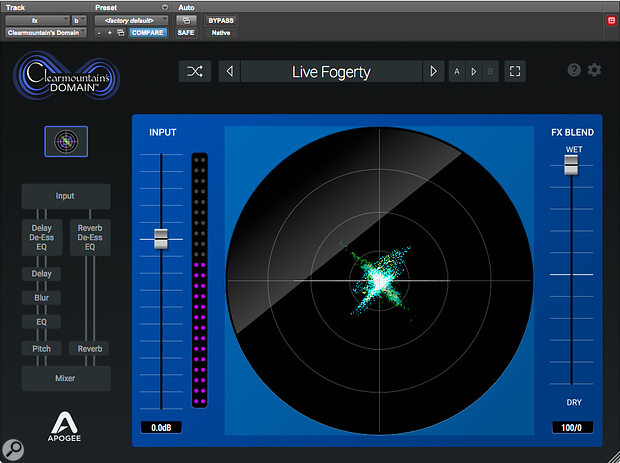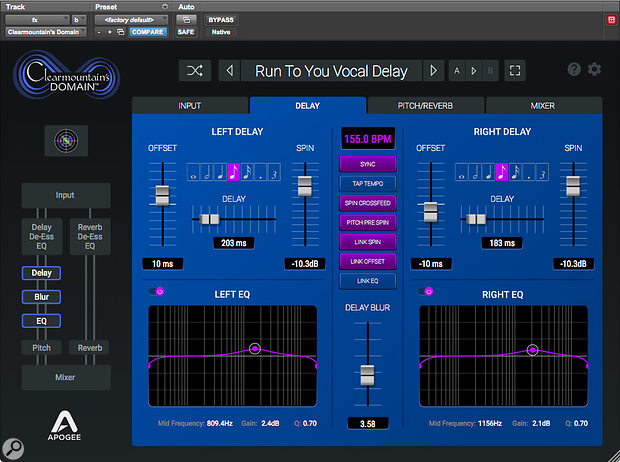Will Bob Clearmountain's signature plug-in help aspiring mix engineers emulate their hero's success?
Signature plug-ins from celebrity mix engineers are nothing new. Some of them replicate unique pieces of custom hardware or favoured golden examples of classic compressors and EQs. Others are presented as 'black boxes' that capture entire signal chains for processing vocals, snare drums, acoustic guitars and so on, usually with minimal user control.
Bob Clearmountain pretty much invented the role of the specialist mix engineer, but it's taken him a while to climb aboard the signature plug-in bandwagon. Now that it's here, though, Clearmountain's Domain is one of the more interesting offerings of its type.
Central to Clearmountain's mixing philosophy is the idea of creating a 'domain': a blend of treated reverb, delay or ambience that gives each mix its own specific character. The techniques that he uses to create these 'domains' rely heavily on the open-ended patching, routing and bussing available on the SSL console. Clearmountain feels that software DAWs lack the flexibility that allows him to create these complex signal chains in the analogue, er, domain.
The Clearmountain's Domain plug-in thus reproduces not only some of the master mixer's favourite effect sources — including the custom reverb chamber at his own Mix This studio — but also the means to link these in some quite involved sequences. As if to prove that we're getting the real deal, it includes a list of 20 or so presets that recreate the 'domains' from some of Clearmountain's most iconic mixes, such as Bryan Adams' 'Run To You', Bowie's 'Let's Dance', INXS's 'Need You Tonight' and several Bruce Springsteen tracks.
Clearmountain's Domain is available for Mac OS and Windows in the usual native formats, and is authorised to an iLok account.
Central to Clearmountain's mixing philosophy is the idea of creating a 'domain': a blend of treated reverb, delay or ambience that gives each mix its own specific character.
Clear Paths
Given the plug-in's stated raison d'être, it's perhaps surprising to find that its internal signal routing is mostly fixed, though it's not obvious that you could usefully patch these effects in a different order. Clearmountain's Domain is based around two semi-independent signal paths, which operate in parallel and can be freely mixed at the output. Each begins with an identical signal conditioning stage comprising a simple de-esser and a basic equaliser providing high- and low-pass filters plus a single parametric band. The first path then proceeds via a stereo delay, saturation processor and a second equaliser, eventually arriving at a stereo pitch-shifter.
The second path is less complex, with the signal-conditioning stage directly feeding three separate convolution reverbs. The first two of these are always Apogee Studio and Mix This Chambers, while the third can be chosen from a shortlist that includes the bathroom and shower at Mix This, as well as a concrete stairwell intended to recall the famous example at New York's Power Station studio that featured on so many classic Clearmountain mixes. The reverbs offer no editing parameters apart from pre-delay, but do give you the option to derive the reverb inputs from the delay/pitch path as well as their own path. The last stage is a simple mixer, where separate outputs from the delay, pitch-shifter, and the three reverbs can be balanced and panned.
 The three reverbs are all available simultaneously, and can be fed both from their own path and from the output of the delay.
The three reverbs are all available simultaneously, and can be fed both from their own path and from the output of the delay.
In contrast to the reverbs, the delays are highly editable. Left and right channels each allow delay time to be set in milliseconds or in beat divisions, with an additional Offset parameter helping to separate them when used at related time divisions. Each channel also has saturation, which for some reason is labelled Blur, and feedback, which for some reason is called Spin, and it's possible to cross the feedback paths to create ping-ponging effects. The pitch-shifter can also optionally be patched into the delay feedback path, enabling the sort of rising or falling echo effects that are exemplified by the 'Let's Dance Breakdown — Descending Stab' preset.
The pitch-shifter is another 'simple but effective' affair, which seems to be optimised for the sort of stereo micro-pitch effects that were often coaxed from Eventide Harmonizers and AMS delay lines. Each channel has fine and semitone shift settings, along with an optional Random button that introduces modulation to keep things from sounding too static.
The message this plug-in sends, loud and clear, is that what matters is not the equipment, but what you do with it.
Public Domain
The Clearmountain's Domain window could politely be described as functional, occupying as it does a slightly uncomfortable middle ground between vintage '80s digital and vintage '90s TDM plug-in. Apart from the equalisers, all parameters are set using sliders and buttons; if you fancy a bit of a light show, you can switch to the graphical display, which represents the effect using animated squiggles on something like a radar screen, but this doesn't present any control over the sound, and offers limited value as a form of visual feedback. Elsewhere, everything is commendably clear, but other than being freely resizable, it's fair to say it doesn't exactly embody the latest trends in interface design.
 The visualiser is pretty, but largely decorative!
The visualiser is pretty, but largely decorative!
Despite the streamlined nature of the reverb and pitch processors, the plug-in as a whole includes a pretty high number of editable parameters, and these are spread over four tabs, so setting up a complex patch from scratch can be time-consuming. As to whether the premise behind the plug-in holds water, I'm on the fence. There are certainly some things you can do here that can't easily be implemented in most DAW mixers, such as patching a pitch-shifter into the feedback path of a delay, but then if that's what you want to achieve, there are existing delay plug-ins with pitch-shifting built in. There are also free or inexpensive plug-in chainers around that allow you to combine reverbs, EQs and other processors in far more complex arrangements than are available here. But if what you want is to easily be able to manipulate an input signal in certain specific ways, then cross-pollinate it to a choice of reverb and delay effects, Clearmountain's Domain will save you a lot of legwork and time. And if you want to know why these specific ways of manipulating an input are particularly valuable, you need only listen to some of the innumerable hits that Bob Clearmountain has mixed — and the presets here that recreate those domains.
What I really like about Clearmountain's Domain, in fact, is precisely the fact that it lets you look inside the black box. Nearly all of the other signature plug-ins I've tried are deliberately opaque: they typically recreate an entire signal chain and offer only a few, cryptically labelled controls. There's none of that magical juju behind-the-curtain stuff here, nor any pretence that you're being admitted into a secret society or given access to some piece of boutique outboard that will change your life.
Summing Up
The message this plug-in sends, loud and clear, is that what matters is not the equipment, but what you do with it. Apart from the reverb chambers, all the individual effects built into Clearmountain's Domain are nowadays pretty generic, and could probably be recreated using the stock plug-ins in most DAWs. The real value on offer lies in the way they're set up and patched together. Clearmountain's Domain is a useful and fertile source of mix-ready effects, but, more than that, it's a masterclass in how the world's greatest mix engineer generates and uses them. As such, I think it perhaps has more to offer to newcomers than to experienced mixers, though I'm pretty sure most of us will learn at least something by scrutinising the way the presets are put together.
Clearmountain's Domain isn't cheap. If you're asked to spring that sort of money on a plug-in, it's usually because it implements a technological breakthrough that does the previously impossible, or because it employs cutting-edge user-interface design that revolutionises an existing task. Neither is true of this plug-in, but what it does offer is a hotline to the expertise of the industry's pre-eminent mix engineer. I'm not sure you can put a price on that.
Pros
- Replicates a complex effects chain that could be hard to set up in your DAW's own mixer.
- Presents a unique window into the techniques and thought processes of perhaps the greatest mix engineer ever.
Cons
- Expensive.
- User interface is somewhat dated.
Summary
There's no 'secret sauce' on offer here but, unlike most signature plug-ins, Clearmountain's Domain provides genuine insight into the techniques that have made its originator the most successful mix engineer ever.

